 |
The Cat SitterSM TribuneMaking "Cat Sense" |
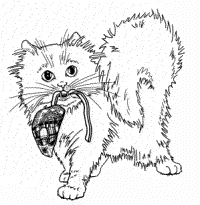 |
Issue Number 17*P.O. Box 232, Roswell, GA 30077*Phone: (770) 594-1010*Fax: (770) 967-4962* January 2004 |
||
Winter 2003/2004 |
||
 |
The Cat SitterSM TribuneMaking "Cat Sense" |
 |
Issue Number 17*P.O. Box 232, Roswell, GA 30077*Phone: (770) 594-1010*Fax: (770) 967-4962* January 2004 |
||
Winter 2003/2004 |
||
Table
of Contents
1.
Notes from Linda Bagne Bartleson
2.
Myths and Facts about
Spaying
3.
Coping with a Cat
that Sprays
4.
Where'd the cats go?
5.
CPR and First Aid
6. The Case of the Disappearing Kitten
7.
Laser Declawing
Procedure
8.
Buddy, a Happy Ending
9.
Looking for a Home
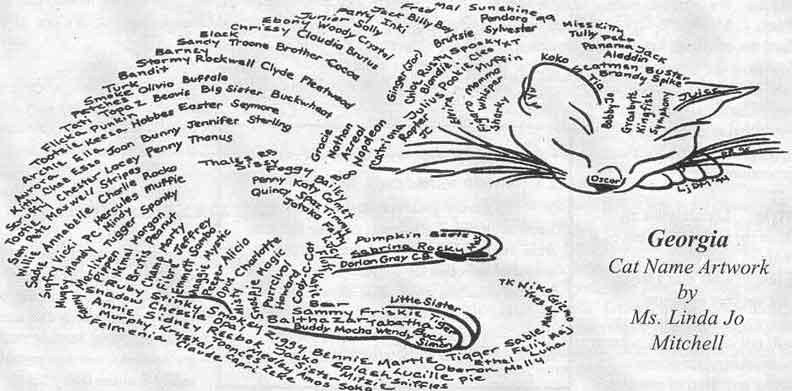
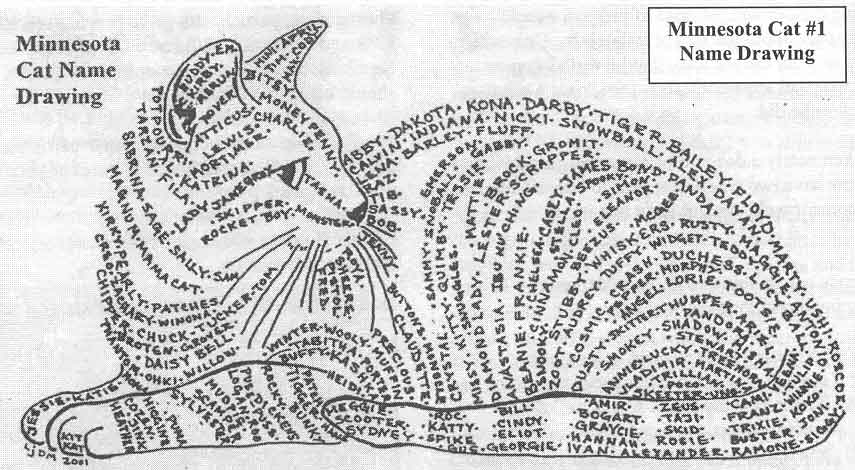
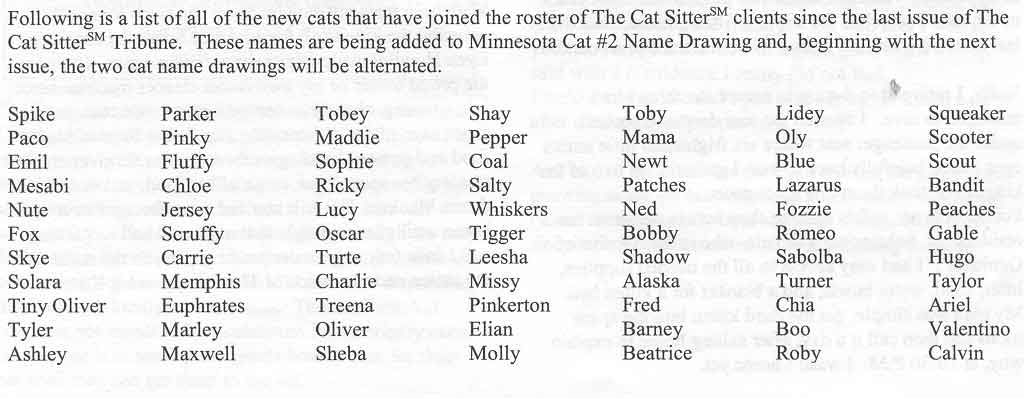
Notes from Linda Bagne Bartleson
Our Condolences: These cats will be dearly missed
Once every few issues of this newsletter, we pause to remember some of the
special customers that have left us. These pets were special, not only to
their owners, but also to us.
Ms. Betty J. Carmack has just published a book that may offer some solace to those who have lost a beloved pet. Look for her "Grieving The Death of a Pet".
Atlanta, GA:
TC Bobby Jo
Al Opus
Harley Mojo
Loco Cody
Spike Katey
Sandy Archie
*The Cat Sitter's family in Georgia lost two of their own, Trouble and Chelsea. They are sorely missed.
Rochester, MN:
Felix Jinx Buttons
Misfit Princess Spike
Samantha Audrey Buffy
Tashi Skid Moseley (Scooter)
Snoball Sam Sylvester
Feline Forum
The information for Feline Forum has been prepared by the Cornell Feline Health Center, Cornell University College of Veterinary Medicine, Ithaca, NY, copyright 2001. It is reprinted here by the gracious permission of the Cornell Feline Health Center.
Myth: My cat will get fat and lazy.
Fact: The truth is that most cats get fat
and lazy because their owners feed them too much and don't give them enough
exercise.
Myth: It's better to have one litter
first.
Fact: Medical evidence indicates just the
opposite. In fact, the evidence shows that females spayed before their
first heat are typically healthier. Many veterinarians now sterilize dogs
and cats as young as eight weeks of age. Check with your veterinarian
about the appropriate time for these procedures.
Myth:
I don't want my male cat to feel like less of a male.
Fact:
Cats don't have any concept of sexual identity or ego. Neutering will not
change a cat's basic personality. He doesn't suffer any kind of emotional
reaction or identity crisis when neutered.
Myth:
It's too expensive to have my cat spayed.
Fact:
The cost of spaying or neutering depends on the sex, size and age of the cat,
your veterinarian's fees, and a number of other variables. But whatever
the actual price, spay or neuter surgery is a one-time cost--a relatively small
cost when compared to all the benefits. It's a bargain compared to the
cost of having a litter and ensuring the health of the mother and litter;
two months of pregnancy and another two months until the litter is weaned can
add up to significant veterinary bills and food costs if complications develop.
Most importantly, it's a very small price to pay for the health of your cat and
prevention of the birth of more unwanted cats.
Myth:
I'll find good homes for all the kittens.
Fact:
You may find homes for all of your cat's litter, but each home you find means
one less home for the cats in shelters that need good homes. Also, in less
than a year's time, each of your cat's offspring may have his or her own litter
adding even more animals to the population. The problem of pet
overpopulation is created and perpetuated one litter at a time.
Excerpted from a list provided by the Humane Society of the United States.
Cats spray (urinate straight back on a vertical surface, usually with the tail held high and quivering) to mark new territory, to let other cats know they've been there, and to give an area its own special smell. Male cats that have not been neutered tend to spray more than neutered males and both more than female cats. Spraying is normal feline behavior -- it's one of the ways they communicate.
Most pet cats are neutered and generally do not spray indoors. But when they do, it is usually a sign they are feeling stressed or threatened by something such as a new cat, baby, or person in the house, or a change of routine.
After ruling out a medical cause, such as cystitis (inflammation of the bladder), and making sure what you're seeing and smelling is on a vertical surface rather than the floor, you can probably safely assume that your cat is spraying, and not just urinating outside the litter box. And if that's the case, some behavior modification may be in order.
Don't hit or yell at your cat when he sprays. It will only make the problem worse. Instead, try to figure out why your cat is feeling insecure and take steps to ease the disruption. If you identify the problem or remove the source, try limiting the area your cat can roam in your house to improve his feeling of security.
As you work to resolve the problem, remain in consultation with your veterinarian. He or she will guide you through the process, and may recommend medication or refer you to specialists in feline behavior.
Cleaning up when your kitty messes up
To ensure that your cat doesn't use the same area twice, you must remove the odor from the items that the cat has sprayed or urinated on. Use an enzyme-based cleaner to deodorize the area. But never use ammonia, because the smell reminds the cat of his own urine smell and tells him that's where he should go to eliminate.
Where'd the cats go?
by Terry & Marilyn Hornseth, Rochester, Minnesota
part of The Cat Sitter staff in Minnesota
"Quit whining!" "Oh please -- quit whining!" "Don't throw up!" All of this and we were only a couple of miles into our first motorhome experience...with lessons to learn!
We are a middle age couple with two cats. A year ago we decided to try motor homing in preparation for retirement. We have a desire to spend half of our retirement year traveling around the US in a motorhome. With an empty nest, it seemed like a great way to see America, take our home with us, and of course also take our cats with us. Our only remaining "family" at home consists of two cats. Tasha is a very vocal 12-pound, long tailed farm girl, now about 8 years old. Calvin is a 16-year-old, 13-pound gentleman, of questionable background, found dumpster diving a dozen years ago. Calvin is a dedicated sun worshipper and official greeter for all who come to our door. While not exactly buddies, they tolerate each other well, and would be terribly lonesome without "that other cat" in the house. Both cats are easy and outgoing.
Our first motorhome experience was an unknown, especially with two cats that never leave the house. As the trip began, Tasha immediately began to tell us that she didn't like the fact that her whole environment was moving. she has a very loud whine. this was well beyond her experience level. She wasn't having fun and she refused to be consoled! Calvin, on the other hand, had helped himself to a small snack just before leaving -- we hadn't noticed. The snack came back squarely on the center of the living room carpet!
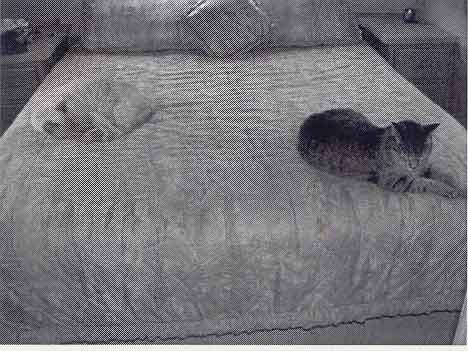
Tasha said, "Wake up, Calvin. Where did they put the litter box?"
At this point, both cats vanished. No more whining, but no more cats either. We pulled off the road in the next town to find the cats. There are only so many places that a cat can hide in a motorhome. Five minutes into the search, we discovered Calvin in a small space between the bedside dresser and the head of the bed, a dark protected space about the size of a shoebox. Only after we pulled him out did we learn that he was sitting on top of Tasha who had apparently found the space a moment or two before he did.
We've taken nearly a dozen trips since that first adventure and we now have two cats that appear to be well adjusted to motorhome travel. We did learn two important lessons:
First, nobody eats within two hours of departure. this is especially important for trips on winding or bumpy roads.
Second, Tasha doesn't want or need to look outside. She is content if she can do her traveling under something and in the dark. In our case, the couch works well for her. She will poke her head out once in awhile to see that we are all still there, but se don't expect her to join us until the engine shuts off.
Calvin,
on the other hand, appears to really enjoy watching traffic. it is not
unusual to see him wandering down the aisle like a drunken sailor, headed back
to the litter box or a favorite bedroom spot in the sun. Once we stop,
both cats return to their regular routines. We love having them on our
trips and we look forward to many miles and many trips with them in the future. CPR and First Aid:
No Longer Just for Humans
The Southeast Minnesota Chapter of the American Red Cross just started offering Pet First Aid. Pet First Aid is meant to protect both pet owners and their pets from further harm, injury, or suffering during emergencies, by teaching prompt, effective actions and care that will safeguard the life of an injured pet. Even though we may feel that we should call 911 for pet emergencies (after all, pets are part of our families), we all know that dispatchers may not look kindly on such calls. The Pet First Aid course is not meant to be a substitute for veterinary care. Its purpose is to teach participants how to care for their pet until they can get to the vet. During class, participants get to practice rescue breathing, CPR and bandaging skills on the Red Cross' cuddly pet manikins. Participants also learn about products that should be included in their pet's first aid kit.
The four hour class is open to human participants of all ages (no pets please, although pictures of your pets are most welcome).
Call the Southeast Minnesota Chapter at 507-287-2200 for more information.
The Case of the Disappearing Kitten
I practice days at my clinic in Rochester and evenings at my clinic in Hayfield. A few weeks ago I was finishing up my evening practice when the front door chime rang. An unexpected caller at the end of the day can indicate an emergency, so I hurried to the reception area. Well, surprise of surprises two little fellows about ten years old stood excitedly before the front desk.
"Say mister," they said, "Did you know there are four kittens living behind your clinic?" "Well, no I didn't," I said, and then added, "Their mother will probably take care of them just fine." "We didn't see any momma cat," one fellow stated quite frankly. "Oh well don't worry, you two just go home now and get a good night's sleep," I said with a confidence I really did not feel. Frankly, it was late and I just was not up for kitten care after a long day of people care.
As I closed the clinic for the night, though, curiosity began gnawing at me. What were four kittens doing behind my clinic? It was awfully cool at night. Where were they sleeping? Was the mother cat really tending to them?
Ready to head home, I drove around to the back of the clinic to check things out. I saw momma cat headed for a large hole in the side of the empty building next to my clinic and the kittens were popping up to say: "Hi Mom!" Uh oh, the kittens, en mass, bopped "Mom" in the nose and "Mom" was backing up, hissing a showing teeth! It was then that I realized that "Mom" was a hungry opossum and the kittens probably would be "goners". I jumped out of the care and chased the opossum, who quickly lumbered off and disappeared between the two buildings. The kittens, of course, had disappeared back into the hole.
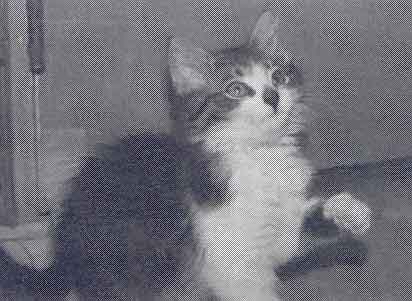
Boy, that opossum really scared me!
I turned on my headlights, ran behind the car and waited. Soon the four little ones popped out of their hold and ambled toward the car. I dashed around to the front of the car and managed to capture two. They bit and kicked and screamed their thanks to me. The others ran off in opposite directions. Dropping the first to in the back seat, I spun around and reached for the last two. I managed to snare a light tan little guy, but his dark brown brother bolted between the two buildings and disappeared. The third kitten was put into the front seat of the car. I searched for another fifteen minutes but the last one had gone into hiding without a trace or a sound.
Sadly, I returned to the car to secure the three I hand managed to save. I opened the rear door and peeked under the passenger seat where six frightened little amber eyes stared balefully back at me. I gathered up two of the kittens and took them to a spare room in my clinic. fortunately my wife's antique shop across the street has a resident cat, Schmoozer, a female, who is the 'Genius of Geniuses'. I had easy access to all the needed supplies, litter, food, water bowls, and a blanket for a kitten bed. My plan was simple, get the third kitten into the spare room and then call it a day, after calling home to explain why, at 10:30 pm, I wasn't home yet.
Back at the car, I found no kitten. I searched everywhere, including the trunk. I guessed the little one had escaped while I was scooping up his siblings. I could not understand how it had gotten past me! I returned to the clinic and fixed up the two rescued kittens with my supplies borrowed from Schmoozer. I locked up the clinic and headed home, sad that I was able to save only two of the four kittens.
About halfway home, I hears some scratchy sounds coming from the dashboard area of the car. I had a suspicion and turned on the heater, the fan, and the interior lights. Then, just as I neared home, some more scratchy sounds heralded two little furry legs, followed by a torso, and then, plop, a whole kitten hit the floor running. He quickly disappeared under the driver's side seat. We made a big U-turn and returned to the clinic.
I arrived back at the clinic around 11 pm. I saw two policemen and asked for help, explaining that I needed help capturing and extracting from my car an elusive kitten. I knew I couldn't do it alone.
We began with one policeman stationed with a flashlight in front of the driver's seat and one in front of the passenger seat. Then I searched under both seats and found no kitten! We all looked again and everyone agreed, no kitten. The police looked at me suspiciously and I was a bit embarrassed. On our third try, I noticed an odd bump in the automobile run in the corner. Poking the bump I received a little foot with little claws kicking my hand. Ah ha! The kitten was the exact shade of tan as the car's rug and it had balled up against the power seat motor with its face buried so no eyes showed. Perfect camouflage! As I extracted the squalling, squirming escape artist I could feel everyone relax. Of course, I named the little kitten Houdini.
With help from my data manager Jan (who loves all animals) the kittens all found a nice home the next day. Even Houdini made it without escaping again. I'm now the proud owner of my own steam cleaner machine since it is amazing what three nervous little kittens can do to a room overnight. Schmoozer, after some days of Sheba food and personal apologies from me had for stealing her spare litter, some of her food, and one of her dozen blankets. I'm still married even though I never got home until after midnight that night and had forgotten to call Linda (my very understanding wife) in the midst of the melee and confusion of The Disappearing Kitten.
Laser Declawing Procedure Offers Exciting Alternative to Traditional Surgery
A new laser declawing procedure (LDP) currently being used at the K-M Regional Veterinary Hospital employs the AccuVet CO2 laser system. This system offers the cat owner a viable alternative for those who want their cats declawed, but hesitate because the traditional procedure is too painful. LDP reduces surgical time, with minimal-to-no bleeding or swelling, and a recovery period under 24-36 hours, as opposed to several days. The laser is idea for many feline procedures, including oral, ophthalmologic, and dermatologic surgeries, tumor removal, and biopsies.
Over the past 3 years, Dr. Bordelon has performed LDP on over 300 cats using the AccuVet CO2 laser system, all with excellent results. Never completely at ease with the traditional declawing procedure due to post surgical pain endured by the patients, Dr. Bordelon was eager to try the LDP and found the difference between it and traditional declawing to be "like night and day".
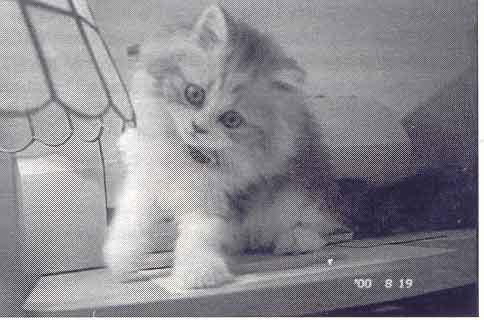
Amir, Jacque and David Jones' companion, was very pleased with his LDP
Cats are often up and walking around within 10 minutes or as soon as they recover from general anesthesia. A soft bandage is applied for 24 hours for comfort and only minimal amounts of surgical glue are required to close the surgical sites. Cats go home in 24 hours, already walking. LDP can be done along with a neuter or spay around 5 months of age. Dr. Bordelon has declawed cats from 3 months to 18 years of age with wonderful results. Being able to do LDP on older cats that might not be candidates for traditional surgery allows for reduced surgical time, reduced general anesthesia, and an overall reduction of stress for the patient.
LDP has been well received. Clients are receptive when they see a less painful procedure for their pet, even if it costs slightly more. Americans have more cats in their households today because we can successfully declaw using Laser Declawing Procedure.
"Buddy" showed up on the doorstep of our office one Monday morning in August. We were unsure of his sex or age, but we know he was hungry! We had crackers in the office and he eagerly ate those as we made an emergency trip to the grocery store for food.
By the end of the day, Buddy had adopted us although he was not very interested in being inside despite the heat outside. He would sit under the trees and watch the comings and goings in the parking lot. When "invited" in he would eat, drink, and leave to return to the cool grass under the trees. Buddy had obviously been someone's pet; he loved attention and would sit on Mike's desk in the warehouse and do "head butts" and purr up a storm! We would feed him right before leaving in the evening, leave some water, and then buddy would be waiting at 6:00 the next morning for breakfast when the warehouse opened.
The employees at the company I work for really wanted to make Buddy our company cat. We had a couple of problems.
We were concerned about feeding him over the weekend. We were worried about dogs that roam freely in the area where our warehouse is located, and-- we have many trucks loading and unloading out of our warehouse and traffic was not "cat friendly".
We decided after three weeks that we should take buddy to the vet, have him checked out and then we would try to find him a good home. Somewhere safe.
I took Buddy to the Veterinary Medical Center on Nesbitt Ferry Road. Dr. Locke checked Buddy out. Yes, he was a male, approximately 10 months old, he had been neutered, and devastatingly, he was FLK positive. We were so sad. After discussion with Dr. Locke, we decided that the best course of action was to put Buddy to sleep. it would be difficult at best to find him a home and we all had cats who were not sick who we could not risk infecting.
It was a sad place at the office! We had thought Buddy was going to come back to the office and we would find him a wonderful home. We did not even consider this happening! But, we felt that we made the only decision we could give, in that Buddy could not come back to the "great outdoors".
The following Sunday (six days later), the phone rang late in the afternoon and it was Heidi Jahn from Veterinary Medical Center. Heidi was calling to say that Buddy was still alive! I nearly fainted! Heidi had decided that Buddy was just too sweet to put to sleep and she was confident she had found a shelter that would take him. She had been trying to contact the owner of the Angel Wings Cat Rescue & Sanctuary in Tennessee and did not want to call us until she was certain that she could arrange for Buddy to go to Angel Wings.
I was over at the clinic within 30 minutes, and Buddy was isolated in a room of his own with a radio for company. I spent almost an hour playing, scratching and talking with him. He was amazing!
It was another week before his transfer could be arranged to Tennessee and I went by several times to see him during the week.
Buddy is now at angel Wings and doing well despite a cold a few weeks ago. thanks to all the employees at Partitions, Inc. General Contractors who fend and cared for Buddy for three weeks, thanks to Heidi for being brave enough to seek another option, and to all the employees and Dr. Locke at Veterinary Medical Center for boarding Buddy temporarily. We hope Buddy is happy and stays well for many years. But at least we know that he is safe, well fed and loved.
Two well-behaved littermates, male and female, seven years old. they come from a good home, but are now living in a foster home. Linda, the Cat Sitter says, "I had the pleasure of taking care of them, they are very sweet".
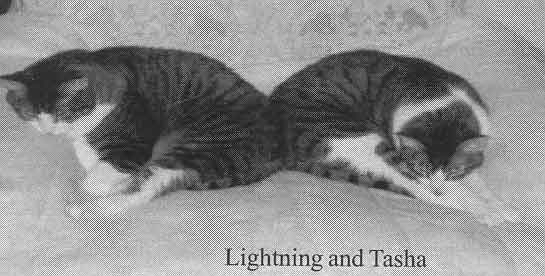
For Over 13 Years We Have Offered Quality TLC Cat Sitting in Rochester, Minnesota and
Roswell, Alpharetta, and Dunwoody, Georgia.
![]()
Franchise Opportunities Available with
THE CAT SITTER
1-800-396-6126
![]()
If you are looking for Country Catnip Toys by the Cat sitter, but cannot fine a retailer, please contact us by fax, phone, or email. We will direct you to the nearest retailer selling the product line. If none is available, we will shoe you how to order direct from us. Be sure to ask about the very popular Magic Pillow.
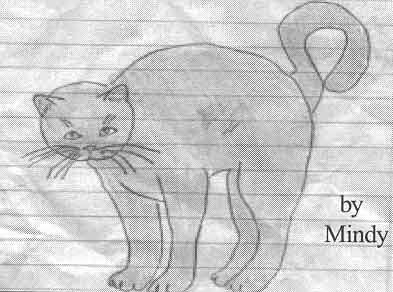
This kitty is a freehand sketch by the daughter of The Cat Sitter in Georgia. It does not need to be said that daddy and mommy think there is talent here.